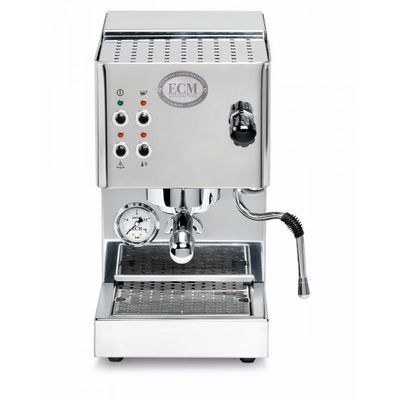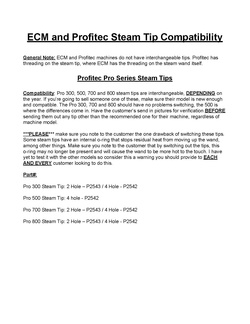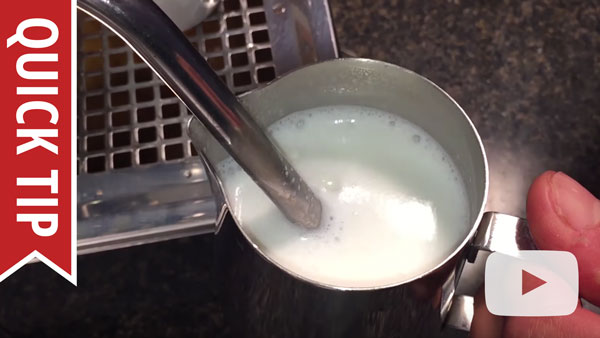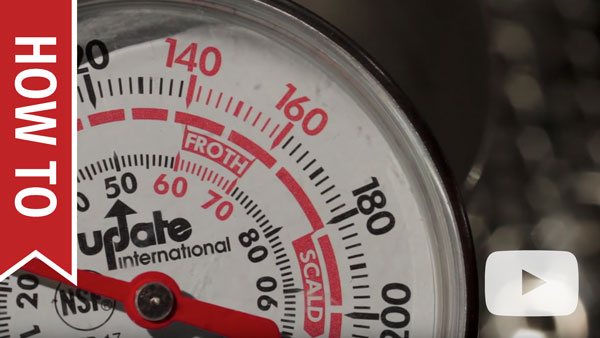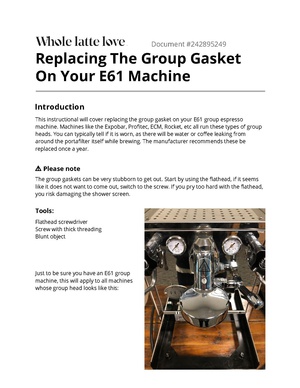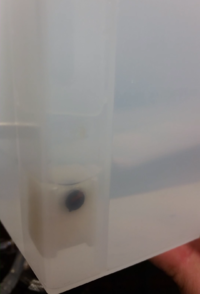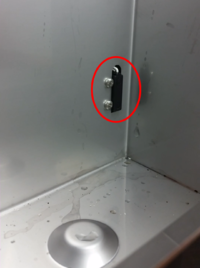Difference between revisions of "Casa V"
From Whole Latte Love Support Library
(Casa V Page) |
(edited wording, removed irrelevant info) |
||
| Line 1: | Line 1: | ||
{{Description-Table | {{Description-Table | ||
|title = ECM Casa V | |title = ECM Casa V | ||
| − | |machine_image = [[File: | + | |machine_image = [[File:CasaV_frontal.jpg|400px|none]] |
|manufacturer = ECM | |manufacturer = ECM | ||
|model_name = ECM Casa V | |model_name = ECM Casa V | ||
| Line 7: | Line 7: | ||
|buy_button = Yes | |buy_button = Yes | ||
|button_size = 400px | |button_size = 400px | ||
| − | |button_link = https://www.wholelattelove.com | + | |button_link = https://www.wholelattelove.com/ecm-casav-semi-automatic-espresso-machine |
}} | }} | ||
==Basic Usage== | ==Basic Usage== | ||
| Line 31: | Line 31: | ||
===No Crema or Bad Tasting Shots=== | ===No Crema or Bad Tasting Shots=== | ||
| − | |||
{{Troubleshooting-No-Crema-Bad-Shots}} | {{Troubleshooting-No-Crema-Bad-Shots}} | ||
===Difficulty Frothing=== | ===Difficulty Frothing=== | ||
| − | |||
{{Troubleshooting-Frothing}} | {{Troubleshooting-Frothing}} | ||
===Flow Issues=== | ===Flow Issues=== | ||
| + | Addressing flow issues starts with cleaning the machine. Before going through these steps please make sure the machine is cleaned according to the [[#Cleaning & Maintenance|Cleaning & Maintenance]] section of this article. | ||
| − | |||
====No Steam Or Hot Water From Wand==== | ====No Steam Or Hot Water From Wand==== | ||
| − | + | #Check the brew function on the machine and see if water is able to flow through the machine. | |
| − | #Check the brew function on the machine and see if water is able to flow through the machine | + | #*If the brew water is not flowing, either refer to the No Flow At All section of this article |
| − | # | + | #*If the brew water flows but is not hot, refer to the On But Not Heating section of this article. |
| − | # | + | |
| − | + | ||
#Turn the hot water function for the wand on and see if the machine can pass hot water through the wand. | #Turn the hot water function for the wand on and see if the machine can pass hot water through the wand. | ||
#If hot water flows through the wand, then there may have been a blockage preventing the steam from coming through. Try steaming again. | #If hot water flows through the wand, then there may have been a blockage preventing the steam from coming through. Try steaming again. | ||
| − | # | + | #Turn the hot water function on for the steam wand to test for flow. |
| − | # | + | #*If nothing comes through refer to the Only Flow From Brew Head section of this article. |
| − | + | #*If water does come through try setting the machine to steam mode again and testing for steam. Running the hot water function can help remove blockages in the steam wand assembly. | |
| − | #If | + | #Unplug the machine and remove the top to check for any loose or disconnected wires, and resecure these connections. |
| + | #If nothing else looks wrong then the steam thermostat has probably failed in will need to be replaced. | ||
| − | |||
| − | |||
| − | |||
| − | ==== | + | ====Only Flow From Steam Wand==== |
| + | Try these steps in the following order. Between each step, test the machine for flow. If flow is restored to the machine, descale immediately before returning to normal use. | ||
| + | #Test the flow of the machine without the portafilter attached. If the machine flows without the portafilter locked in, then one of the filter baskets is blocking flow. Clean the baskets by soaking them in a solution of hot water and backflushing powder for 30 minutes, or boiling the baskets for 30 minutes. | ||
| + | #Make sure the brew group is completely clean and free of debris. Inspect the shower screen for clogs or blockages by removing it and holding it up to a light source. | ||
| − | |||
| + | |||
| + | ====No Flow At All==== | ||
| + | If there is no water flow whatsoever, follow the instructions below. Once flow is restored, make sure to pull a full 8 oz. of water using the hot water function to ensure the machine is correctly primed. | ||
#Check the water tank to make sure it is filled to the max line. | #Check the water tank to make sure it is filled to the max line. | ||
#Make sure the tank is sitting flush, and that the water tank valve is properly inserting in the socket. | #Make sure the tank is sitting flush, and that the water tank valve is properly inserting in the socket. | ||
| − | |||
| − | |||
| − | |||
#Activate the hot water function on the machine. You should hear a vibration noise coming from the machine to indicate that the pump is activated. | #Activate the hot water function on the machine. You should hear a vibration noise coming from the machine to indicate that the pump is activated. | ||
| − | # | + | #*If you can't hear anything coming from the machine then there may be a loose or disconnected wire inside of the machine. Unplug the machine and remove the casing to inspect the inside for any loose or disconnected wires, particularly at the pump or the front switch panel. Firmly secure any loose wires and test flow again using the hot water function. |
| − | # | + | #*If you hear the machine vibrating then the pump is turning on. Unplug the machine and remove the casing to inspect the water lines inside the machine. Make sure there aren't any loose, kinked, or disconnected hoses anywhere. |
| + | #The pump of the machine may be vapor locked, requiring a force prime of the unit. | ||
| + | #*To force prime this unit take a kitchen syringe, turkey baster, or priming pump and fill it with water. | ||
| + | #*Insert the tip of it into the inlet line of the machine. | ||
| + | #*Activate the hot water function of the machine. When you hear the pump kick on quickly force water with your priming tool. | ||
| + | #*Immediately turn the machine off to prevent air from being drawn into the line. | ||
| + | #*Repeat this process multiple times. After 3-4 manual primes you should start to see water spitting from the steam wand. Once this happens you can put the inlet line back into the tank and try to prime the machine normally by pulling 8 oz. of water through the machine using the hot water function. | ||
| Line 78: | Line 80: | ||
{{Troubleshooting-Prosumer-Bad-Gasket | {{Troubleshooting-Prosumer-Bad-Gasket | ||
| − | |gasket_instr = | + | |gasket_instr = Instructions for replacing the group gasket can be found on pp.27-28 of the machine manual. |
}} | }} | ||
| − | |||
| − | |||
| − | |||
| − | |||
| − | |||
| − | |||
| − | |||
| − | |||
| − | |||
| − | |||
| − | |||
| − | |||
| − | |||
| − | |||
| − | |||
| − | |||
| − | |||
| − | |||
| − | |||
| − | |||
| − | |||
| − | |||
====From Bottom Of Machine==== | ====From Bottom Of Machine==== | ||
| − | + | #Check the water tank and drip tray to make sure that are no cracks or breaks where water can escape. Make sure the tank and drip tray are properly inserted into the machine. The valve on the bottom of the water tank needs to be fully inserted into the corresponding socket for it to seal properly. | |
| − | #Check the water tank and drip tray to make sure that are no cracks or breaks where water can escape. Make sure | + | |
#Unplug the machine and remove the cover and top. Check for any loose or broken water connections, or any valve assemblies that are leaking. | #Unplug the machine and remove the cover and top. Check for any loose or broken water connections, or any valve assemblies that are leaking. | ||
| − | #Examine the pump and boiler assemblies to see if there are any cracks in them. If the machine was exposed to subfreezing conditions without being properly drained | + | #Examine the pump and boiler assemblies to see if there are any cracks in them. If the machine was exposed to subfreezing conditions without being properly drained, the process of water forming into ice can cause these parts to crack. |
| + | |||
====From Steam Wand==== | ====From Steam Wand==== | ||
#If the wand is leaking from the tip it means the steam valve is not fully closed. | #If the wand is leaking from the tip it means the steam valve is not fully closed. | ||
| − | # | + | #*Try tightening the knob down firmly. Pressure from the boiler will leak through the wand if the steam valve is not securely closed. |
| − | # | + | #*If it feels like the knob is spinning in place then the knob may be broken. Try removing the knob and manually turning the steam valve closed. An adjustable wrench or a pair of pliers can help with this. If this stops the leaking then the square hole in the knob may have been deformed from over tightening, or the bow nut that secures the knob to the valve assembly may be stripped. |
| − | # | + | #*Descale the machine according to the instructions in the Cleaning & Maintenance section of this article. Scale buildup inside of the steam valve will prevent the valve from closing fully and can cause permanent damage to the valve. After the machine has been descaled run 4-6 tanks of water through the wand using the machine's hot water function to ensure any debris or scale in the valve is fully removed. |
| − | # | + | #*If the leaking persists then the steam valve will need to be replaced. |
#If the wand is leaking from behind the knob assembly, then the nut that secures the valve tap needs to be tightened down. Part 5 on p.8 of the diagram needs to be tightened down. | #If the wand is leaking from behind the knob assembly, then the nut that secures the valve tap needs to be tightened down. Part 5 on p.8 of the diagram needs to be tightened down. | ||
#If the wand is leaking from where it connects to the machine then the wand is not sealing properly to the supply line. Make sure the wand is properly secured to the supply line by tightening part number 33 on p.8 of the diagram. | #If the wand is leaking from where it connects to the machine then the wand is not sealing properly to the supply line. Make sure the wand is properly secured to the supply line by tightening part number 33 on p.8 of the diagram. | ||
#If the wand is leaking from the ball joint: | #If the wand is leaking from the ball joint: | ||
| − | # | + | #*First remove the wand arm. This can be done by unscrewing the hex shaped nut at the top of the arm, part 13 on p.8 of the parts diagram. |
| − | # | + | #*Once the wand is removed there may be parts that stick to the valve assembly. Do not lose these parts. |
| − | # | + | #*If the leaking was coming from the top of the securing nut, check the o-ring (part 9) to make sure it is clean and not damaged. |
| − | # | + | #*Inspect the tension spring to make sure it is in good condition. The spring should be really firm. If it is easily compressed then it may need to be replaced. At the bottom of the spring are parts 11 and 12. These mate with the ball joint on the wand to let it pivot. Make sure these parts are clean and reinstall them. |
| Line 131: | Line 111: | ||
{{Troubleshooting-Prosumer-Brew-Cold | {{Troubleshooting-Prosumer-Brew-Cold | ||
| − | |||
| − | |||
|hls_instr = Remove the outer casing and top of the machine in order to access the top of the boiler where the high limit switch is located. The switch has a small button in the center that will need to be pressed a few times to reset it. The high limit switch is listed as part 3 on p.6 of the machine's parts diagram. | |hls_instr = Remove the outer casing and top of the machine in order to access the top of the boiler where the high limit switch is located. The switch has a small button in the center that will need to be pressed a few times to reset it. The high limit switch is listed as part 3 on p.6 of the machine's parts diagram. | ||
}} | }} | ||
| Line 144: | Line 122: | ||
===Portafilter Handle Not Fitting On Machine=== | ===Portafilter Handle Not Fitting On Machine=== | ||
| − | |||
{{Troubleshooting-Prosumer-Portafilter}} | {{Troubleshooting-Prosumer-Portafilter}} | ||
| + | |||
==Diagrams & Manuals== | ==Diagrams & Manuals== | ||
{{Support-Documents | {{Support-Documents | ||
| − | |title = ECM | + | |title = ECM Casa V |
| − | + | ||
| − | + | ||
}} | }} | ||
| Line 159: | Line 136: | ||
{{Specifications-Prosumer | {{Specifications-Prosumer | ||
|basic_specs = yes | |basic_specs = yes | ||
| − | |width = | + | |width = 8.6 in. |
| − | |height = | + | |height = 14.96 in. |
| − | |depth = | + | |depth = 14.56 in. |
| − | |weight = | + | |weight = 30.86 lbs |
|watts = 1200 | |watts = 1200 | ||
| − | |volts = | + | |volts = 110V-120V (US) |
|housing = yes | |housing = yes | ||
| Line 189: | Line 166: | ||
|water_source = yes | |water_source = yes | ||
|source_type = Reservoir | |source_type = Reservoir | ||
| − | |reservoir_capacity = | + | |reservoir_capacity = 94 oz |
|reservoir_material = Plastic | |reservoir_material = Plastic | ||
|reservoir_access = Top | |reservoir_access = Top | ||
| Line 195: | Line 172: | ||
|controls = Yes | |controls = Yes | ||
| − | |control_type = | + | |control_type = Push Button |
| − | |display_type = | + | |display_type = Indicator Lights |
|power_light = Yes | |power_light = Yes | ||
|temp_control = Yes | |temp_control = Yes | ||
| Line 220: | Line 197: | ||
|brew_group = yes | |brew_group = yes | ||
|group_material = Chrome Plated Brass | |group_material = Chrome Plated Brass | ||
| − | |group_type = | + | |group_type = Other |
|preheat = Yes | |preheat = Yes | ||
|solenoid = Manual | |solenoid = Manual | ||
| Line 232: | Line 209: | ||
|brew_boiler_type = Single Boiler | |brew_boiler_type = Single Boiler | ||
|brew_boiler_wattage = 1200 | |brew_boiler_wattage = 1200 | ||
| − | |brew_boiler_volume = | + | |brew_boiler_volume = 13 Oz |
|brew_boiler_material = Stainless Steel | |brew_boiler_material = Stainless Steel | ||
|brew_boiler_orientation = Vertical | |brew_boiler_orientation = Vertical | ||
|brew_element_location = Internal | |brew_element_location = Internal | ||
| − | |brew_boiler_autofill = | + | |brew_boiler_autofill = Yes |
|pump_data = yes | |pump_data = yes | ||
Revision as of 14:06, 24 October 2017
| ECM Casa V |
|---|
| Manufacturer: ECM |
| Model Name: ECM Casa V |
| Type: Semi-Automatic |
Contents
Basic Usage
Getting Started
Adjusting Brew Pressure
The machine is designed to brew at 9 bar with a flow of about 2 oz in 20-25 seconds. To adjust the brew pressure, install the backflush disc and press the brew button, then turn the adjustment screw located beneath the removable cup warmer until you get to 10 bar on the brew pressure gauge. This will result in 9 bar brew pressure. Turning the adjustment screw clockwise will raise the pressure and turning counterclockwise will lower it.
Note: Brew pressure does not need to be exactly 9 bar for great coffee. It can a little above or below that mark without affecting results in the cup.
Steam Tip Compatibility
Cleaning & Maintenance
Proper machine maintenance is critical to proper machine functionality. Most machine failures are caused by a lack of cleaning and maintenance. This is vital, as many manufacturer warranties do not cover cleaning/maintenance related breakdowns. To avoid this, it is imperative to keep a regular maintenance schedule. Listed below is a suggested maintenance rundown for most semi-automatic espresso machines:
Descaling
Descaling the machine should be done on a bimonthly basis using the product recommended by the manufacturer. Descaling is still required even if reverse osmosis, distilled, or zero water is being used. Refer to your machine manual for specific instructions for this unit.
Backflushing
The machine should be backflushed once a week to prevent scale buildup in the brew group and valve assemblies. Instructions for backflushing the machine can be found in the video below or on page 24 of your user manual.
Instructions for backflushing the machine can be found in the video below.Grouphead Cleaning
The grouphead should be taken apart on a monthly basis to remove scale buildup, remove coffee residues, and improve shot flavor.
Steam Wand Cleaning
Steam wands, steam tips, and nozzle attachments should be cleaned daily after the machine is finished being used for the day. Milk residues quickly build up on steam wands and frothing nozzles, so it is important to keep these clean to prevent blockages from forming.
Replacing Group Gasket
The group gasket will typically need to be replaced approximately every six months to a year. It is not necessary to replace the gasket until leaking at the grouphead occurs, but it is good to have a gasket on hand since the machine cannot be used with a broken gasket. Instructions can be found on page 25 of your user manual.
Recommended Cleaning Products
The compatible descaling products for this machine are Urnex Full Circle. The best product for cleaning metal grouphead components and filter baskets is a backflushing powder like Urnex Cafiza.
Troubleshooting
No Crema or Bad Tasting Shots
Typically, issues with crema or the flavor of the shot do not indicate a malfunction of the machine. Instead, this indicates that an adjustment needs to be made in the brewing process or that different beans need to be used.
The following articles review the different variables and offer solutions:
- Tamping The Correct Way and The Effects Of Tamping Pressure
- Grinding Coffee For Espresso
- It is important to use fresh beans, typically beans roasted within the past two weeks are best. Light and medium roasts are best for espresso brewing and richer crema. Storing beans properly is also important, more information can be found here.
If the behavior persists after reviewing these factors then the machine may need to be cleaned. Lack of cleaning can cause burned or bitter flavors, or create flow issues which can result in a weak shot. Navigate to the Cleaning & Maintenance icon above for more information.
Difficulty Frothing
As with brewing, technique is critical to frothing well. Frothing is very sensitive to technique, which has a steep learning curve. If the machine is producing steam then an adjustment to technique may need to be made. The video on the right shows proper frothing technique.
Many frothing mistakes are common missteps that result in poor or no froth. The video on the right identifies these mistakes and shows how to correct them.
It is also important not to overheat your milk. The milk will have the sweetest and most velvety texture between 140-150 F°. As you froth past this point the milk will lose its sweetness, the froth will take on a gummier texture, and eventually the milk will scald and begin to taste burnt. The video on the right explains how to use a frothing thermometer so that the milk is kept within the ideal range.
Flow Issues
Addressing flow issues starts with cleaning the machine. Before going through these steps please make sure the machine is cleaned according to the Cleaning & Maintenance section of this article.
No Steam Or Hot Water From Wand
- Check the brew function on the machine and see if water is able to flow through the machine.
- If the brew water is not flowing, either refer to the No Flow At All section of this article
- If the brew water flows but is not hot, refer to the On But Not Heating section of this article.
- Turn the hot water function for the wand on and see if the machine can pass hot water through the wand.
- If hot water flows through the wand, then there may have been a blockage preventing the steam from coming through. Try steaming again.
- Turn the hot water function on for the steam wand to test for flow.
- If nothing comes through refer to the Only Flow From Brew Head section of this article.
- If water does come through try setting the machine to steam mode again and testing for steam. Running the hot water function can help remove blockages in the steam wand assembly.
- Unplug the machine and remove the top to check for any loose or disconnected wires, and resecure these connections.
- If nothing else looks wrong then the steam thermostat has probably failed in will need to be replaced.
Only Flow From Steam Wand
Try these steps in the following order. Between each step, test the machine for flow. If flow is restored to the machine, descale immediately before returning to normal use.
- Test the flow of the machine without the portafilter attached. If the machine flows without the portafilter locked in, then one of the filter baskets is blocking flow. Clean the baskets by soaking them in a solution of hot water and backflushing powder for 30 minutes, or boiling the baskets for 30 minutes.
- Make sure the brew group is completely clean and free of debris. Inspect the shower screen for clogs or blockages by removing it and holding it up to a light source.
No Flow At All
If there is no water flow whatsoever, follow the instructions below. Once flow is restored, make sure to pull a full 8 oz. of water using the hot water function to ensure the machine is correctly primed.
- Check the water tank to make sure it is filled to the max line.
- Make sure the tank is sitting flush, and that the water tank valve is properly inserting in the socket.
- Activate the hot water function on the machine. You should hear a vibration noise coming from the machine to indicate that the pump is activated.
- If you can't hear anything coming from the machine then there may be a loose or disconnected wire inside of the machine. Unplug the machine and remove the casing to inspect the inside for any loose or disconnected wires, particularly at the pump or the front switch panel. Firmly secure any loose wires and test flow again using the hot water function.
- If you hear the machine vibrating then the pump is turning on. Unplug the machine and remove the casing to inspect the water lines inside the machine. Make sure there aren't any loose, kinked, or disconnected hoses anywhere.
- The pump of the machine may be vapor locked, requiring a force prime of the unit.
- To force prime this unit take a kitchen syringe, turkey baster, or priming pump and fill it with water.
- Insert the tip of it into the inlet line of the machine.
- Activate the hot water function of the machine. When you hear the pump kick on quickly force water with your priming tool.
- Immediately turn the machine off to prevent air from being drawn into the line.
- Repeat this process multiple times. After 3-4 manual primes you should start to see water spitting from the steam wand. Once this happens you can put the inlet line back into the tank and try to prime the machine normally by pulling 8 oz. of water through the machine using the hot water function.
Machine Is Leaking
Between Portafilter & Grouphead
If the machine is leaking from between the grouphead and the portafilter then the grouphead gasket is either pushed out of place and needs to be reinserted properly, or the gasket is worn out. Typically, grouphead gaskets will wear out in approximately 6 months to a year depending on how heavily the machine is used. Premature wear to this gasket can be caused by using excessive force when attaching the portafilter. It is important to distinguish where the leaking is occurring. If the leaking is originating from farther up on the grouphead assembly and then draining down to where the portafilter is attached, then refer to the section of this article which discusses leaking from the grouphead.
If the leaking is coming from between the portafilter and grouphead where you twist the handle on, then the gasket will need to be replaced. Instructions for replacing the group gasket can be found on pp.27-28 of the machine manual. You can try using the instructions to clean and reseat the current gasket. If that does not resolve the leak then the gasket will need to be replaced.
The gasket can get stuck in the grouphead from wear or excessive heat exposure. To remove the gasket take some self-tapping screws and partially screw them into the group gasket. Make sure not to go all the way through the gasket because you can scratch/dent the grouphead if you go too far. Then use a pair of pliers to pull on the screws and the gasket will pull out with them.
From Bottom Of Machine
- Check the water tank and drip tray to make sure that are no cracks or breaks where water can escape. Make sure the tank and drip tray are properly inserted into the machine. The valve on the bottom of the water tank needs to be fully inserted into the corresponding socket for it to seal properly.
- Unplug the machine and remove the cover and top. Check for any loose or broken water connections, or any valve assemblies that are leaking.
- Examine the pump and boiler assemblies to see if there are any cracks in them. If the machine was exposed to subfreezing conditions without being properly drained, the process of water forming into ice can cause these parts to crack.
From Steam Wand
- If the wand is leaking from the tip it means the steam valve is not fully closed.
- Try tightening the knob down firmly. Pressure from the boiler will leak through the wand if the steam valve is not securely closed.
- If it feels like the knob is spinning in place then the knob may be broken. Try removing the knob and manually turning the steam valve closed. An adjustable wrench or a pair of pliers can help with this. If this stops the leaking then the square hole in the knob may have been deformed from over tightening, or the bow nut that secures the knob to the valve assembly may be stripped.
- Descale the machine according to the instructions in the Cleaning & Maintenance section of this article. Scale buildup inside of the steam valve will prevent the valve from closing fully and can cause permanent damage to the valve. After the machine has been descaled run 4-6 tanks of water through the wand using the machine's hot water function to ensure any debris or scale in the valve is fully removed.
- If the leaking persists then the steam valve will need to be replaced.
- If the wand is leaking from behind the knob assembly, then the nut that secures the valve tap needs to be tightened down. Part 5 on p.8 of the diagram needs to be tightened down.
- If the wand is leaking from where it connects to the machine then the wand is not sealing properly to the supply line. Make sure the wand is properly secured to the supply line by tightening part number 33 on p.8 of the diagram.
- If the wand is leaking from the ball joint:
- First remove the wand arm. This can be done by unscrewing the hex shaped nut at the top of the arm, part 13 on p.8 of the parts diagram.
- Once the wand is removed there may be parts that stick to the valve assembly. Do not lose these parts.
- If the leaking was coming from the top of the securing nut, check the o-ring (part 9) to make sure it is clean and not damaged.
- Inspect the tension spring to make sure it is in good condition. The spring should be really firm. If it is easily compressed then it may need to be replaced. At the bottom of the spring are parts 11 and 12. These mate with the ball joint on the wand to let it pivot. Make sure these parts are clean and reinstall them.
Machine Not Heating Or Powering On
No Power
- Make sure the machine is plugged into an appropriate power source.
- Do not use the machine on a surge protector. This machine has a high power draw, more than a typical kitchen appliance such as a refrigerator or a microwave. Surge protectors are typically not rated to handle the amperage this machine requires.
- Try using the machine on a different outlet, and make sure the machine is the only appliance plugged into that outlet.
- Make sure the power switches are functioning properly and not broken. If the machine isn't powering on try pressing and holding the power button in the on position to see if the machine turns on. If you are able to power the machine on this way then the power switch needs to be replaced.
- If the machine recently had a leak, had water spilled on it, or any other exposure to moisture then the machine may be shorting out. Try letting the machine sit unplugged for 48 hours to make sure there isn't a short caused by moisture.
Brew Not Heating
- Give the machine sufficient time to heat up. A heating time of 20-30 minutes is recommended for prosumer style machines for it to be sufficiently heated for brewing. Make sure the portafilter is attached during heating.
- Make sure the heating indicator is on. If the heating indicator is not on, then the machine will not heat. Typically this light will be off if the machine is out of water or not able to fill the boiler.
- The pressurestat may be set too low resulting in a lower temperature. Be cautious when adjusting the pressurestat. Setting it too high can cause the machine to overheat, resulting in the pressure relief valve blowing off excess steam.
- The high limit switch may be tripped and needs to be reset. Remove the outer casing and top of the machine in order to access the top of the boiler where the high limit switch is located. The switch has a small button in the center that will need to be pressed a few times to reset it. The high limit switch is listed as part 3 on p.6 of the machine's parts diagram.
- The heating element may be broken and may require replacement.
On But Not Heating
- The water tank magnet may be sitting in the machine incorrectly, or the water tank sensor wiring may be loose or disconnected. The machine will not function unless is senses that water is in the tank.
- The water tank magnet is embedded in a white plastic float, which can be found in the front left corner of the water tank. The float should be positioned so that the magnet is on the top and is facing the corner of the tank.
- The magnet needs to be aligned with this sensor. If the magnet is positioned properly but the machine still thinks there is no water, then there may be a wire loose/disconnected on the sensor.
- There is a loose, disconnected, or broken wire inside the machine. Remove the top of the machine and inspect the wiring.
- The high limit switch of the machine may have tripped. Remove the outer casing and top of the machine in order to access the top of the boiler where the high limit switch is located. The switch has a small button in the center that will need to be pressed a few times to reset it. The high limit switch is listed as part 3 on p.6 of the machine's parts diagram. Please note that this machine does not have an auto-fill function for the boiler. The boiler must be manually refilled after any time the steam function has been used. The machine can overheat if the boiler is not filled.
- The outlet the machine is plugged into is not rated to handle the power draw of the machine.
Portafilter Handle Not Fitting On Machine
- On all new machines, the portafilter may or may not fit perpendicular to the machine. This is perfectly normal. This is because the grouphead gasket requires time to wear in before this can happen. As long as you can get the portafilter hand tight onto the machine and brew without leaking, then the machine is operating properly.
- Too much coffee may be dosed into the portafilter. If there is too much coffee in the portafilter, it can press into the shower screen and prevent the portafilter tightening all the way. Reduce the amount of coffee in the portafilter and try again. If you see an indentation from the shower screen in the grounds, then you’ve added too much.
- Check the filter baskets for dings, dents, or any sort of warping. A filter basket that is malformed can prevent the filter basket from sealing up against the group gasket.
- The group gasket has slipped out of place or needs replacing. Please refer to the section of this article which discusses gasket issues for instructions on how to test the gasket or replace it.
Diagrams & Manuals
| ECM Casa V | |
|---|---|
| Electrical Diagram: | Not Available |
| Hydraulic Diagram: | Not Available |
| Machine Manual: | Not Available |
| Parts Diagram: | Not Available |
| Service Manual | Not Available |
| Startup Guide: | Not Available |
Specifications
| Basic Specs | |
|---|---|
| Width: | 8.6 in. |
| Height: | 14.96 in. |
| Depth: | 14.56 in. |
| Weight: | 30.86 lbs |
| Wattage: | 1200 |
| Voltage: | 110V-120V (US) |
| Housing | |
| Housing Materials: | Stainless Steel |
| Drip Tray Material: | Stainless Steel |
| Drip Tray Cover Material: | Stainless Steel |
| Drip Tray Capacity: | 32 oz |
| Drain Line Adaptable: | No |
| Tall Legs: | Yes |
| Power Cord Length: | 48 in. |
| Cup Height | |
| Max Cup Height: | 3.25 in. |
| Frothing | |
| Material: | Stainless Steel |
| Steam Wand Style: | Commercial Style |
| Wand Movement: | Articulating |
| Usable Length: | 4 in. |
| Height Off Counter: | 4 to 6.5 in. |
| Number Of Holes: | 2 |
| Water Source | |
| Reservoir Or Plumbed: | Reservoir |
| Reservoir Capacity: | 94 oz |
| Reservoir Material: | Plastic |
| Reservoir Access: | Top |
| Reservoir Removable: | Yes |
| Controls | |
| Type Of Controls: | Push Button |
| Display Type: | Indicator Lights |
| Power Light: | Yes |
| Temperature Control: | Yes |
| Low Water Warning: | Yes |
| Pressure Gauges: | Brew Only |
| Brew Temperature Display: | Yes |
| Cup Warmer | |
| Material: | Stainless Steel |
| Size: | 10 X 10 in. |
| Passive / Active: | Passive |
| Portafilter Data | |
| Material: | Chrome Plated Brass |
| Type: | Commercial Style |
| Quantity Included: | 1 |
| Weight: | 1.25 lbs |
| Diameter: | 58 mm. |
| Commercial Filter Baskets Included: | Single & Double |
| Bottomless Portafilter Available: | Yes |
| Tamper Size: | 58 mm. |
| Brew Group | |
| Material: | Chrome Plated Brass |
| Type: | Other |
| Preheat: | Yes |
| Three-Way Valve: | Manual |
| Back Flush Capable: | Yes |
| Boiler Data | |
| Number Of Boilers: | 1 |
| Brew & Steam Simultaneously: | No |
| Brew Boiler Data | |
| Boiler Type: | Single Boiler |
| Boiler Wattage: | 1200 |
| Boiler Voulme: | 13 Oz |
| Boiler Material: | Stainless Steel |
| Boiler Orientation: | Vertical |
| Element Location: | Internal |
| Brew Boiler Auto Fill: | Yes |
| Pump Data | |
| Pump Type: | Vibration |
| Wattage: | 52 |
| Max Pressure: | 15 Bar |
| Brew Pressure Adjustability: | Yes |
| Self Priming: | Yes |
| Performance | |
| Initial Heat Up: | 300 s. |
| Recommended Heat Up: | 600 s. |
| Time To Steam (8 oz.): | 45 s. |
| Hot Water Temp (8 oz.): | 177 F° |
| Hot Water Time (8 oz.): | 20 s. |
| Hot Water Recovery Time: | 74 s. |
| Sound Level Brewing: | 63 Db |
| Details | |
| Country Of Manufacture: | Italy |
| NSF Certified: | No |
| Recommended Application: | Home Use |
